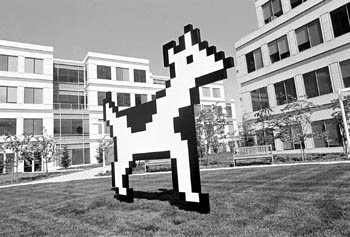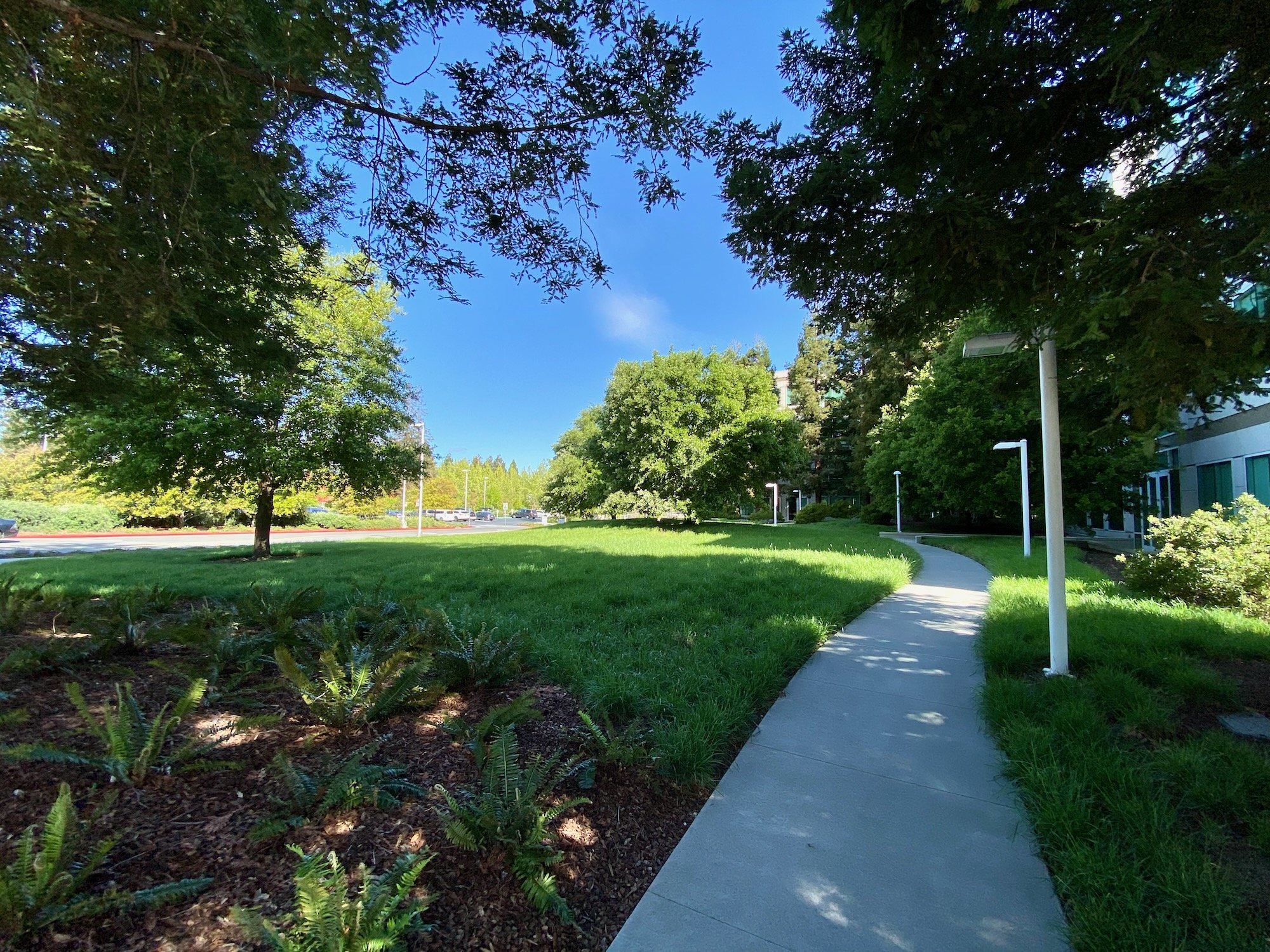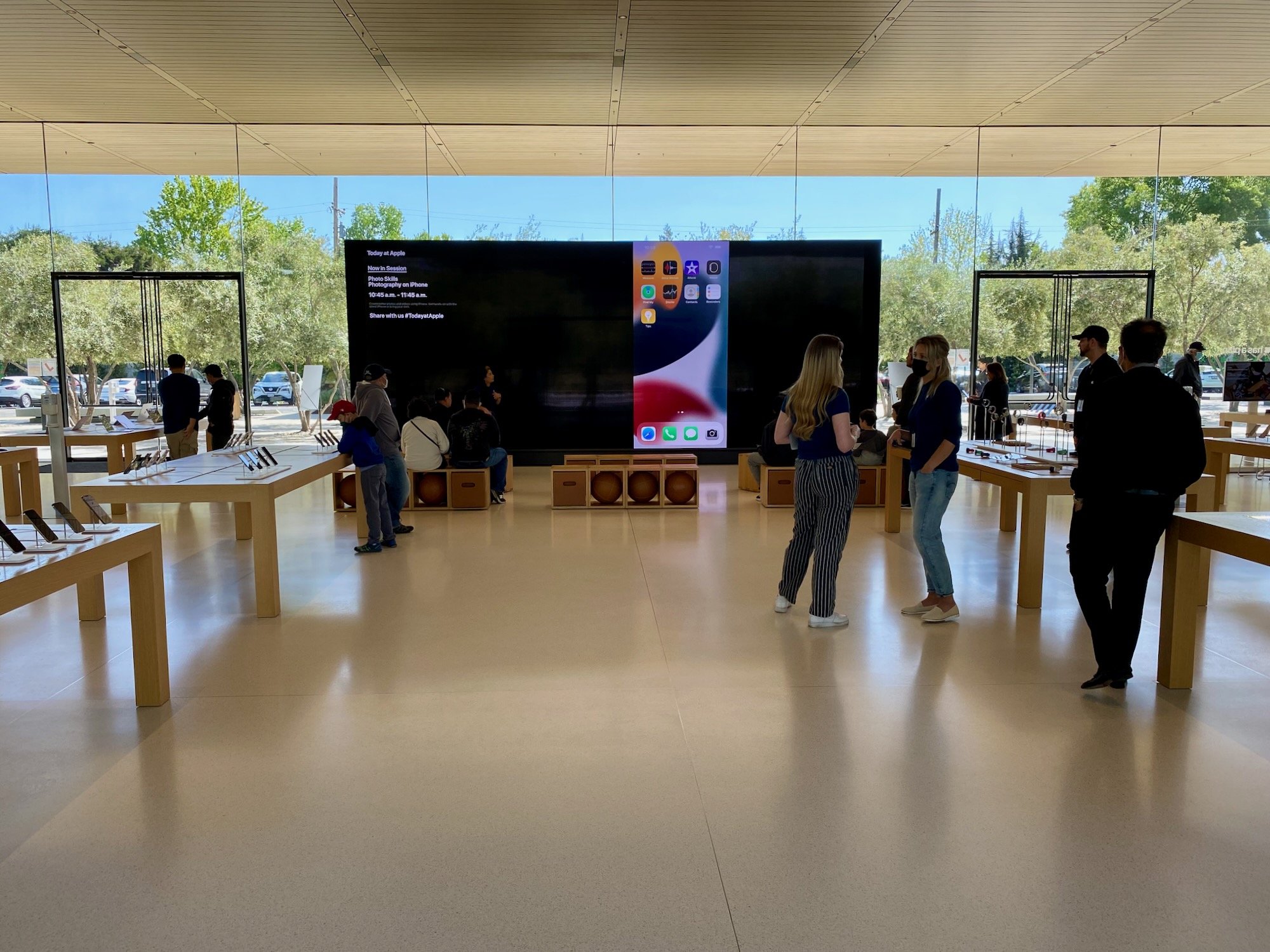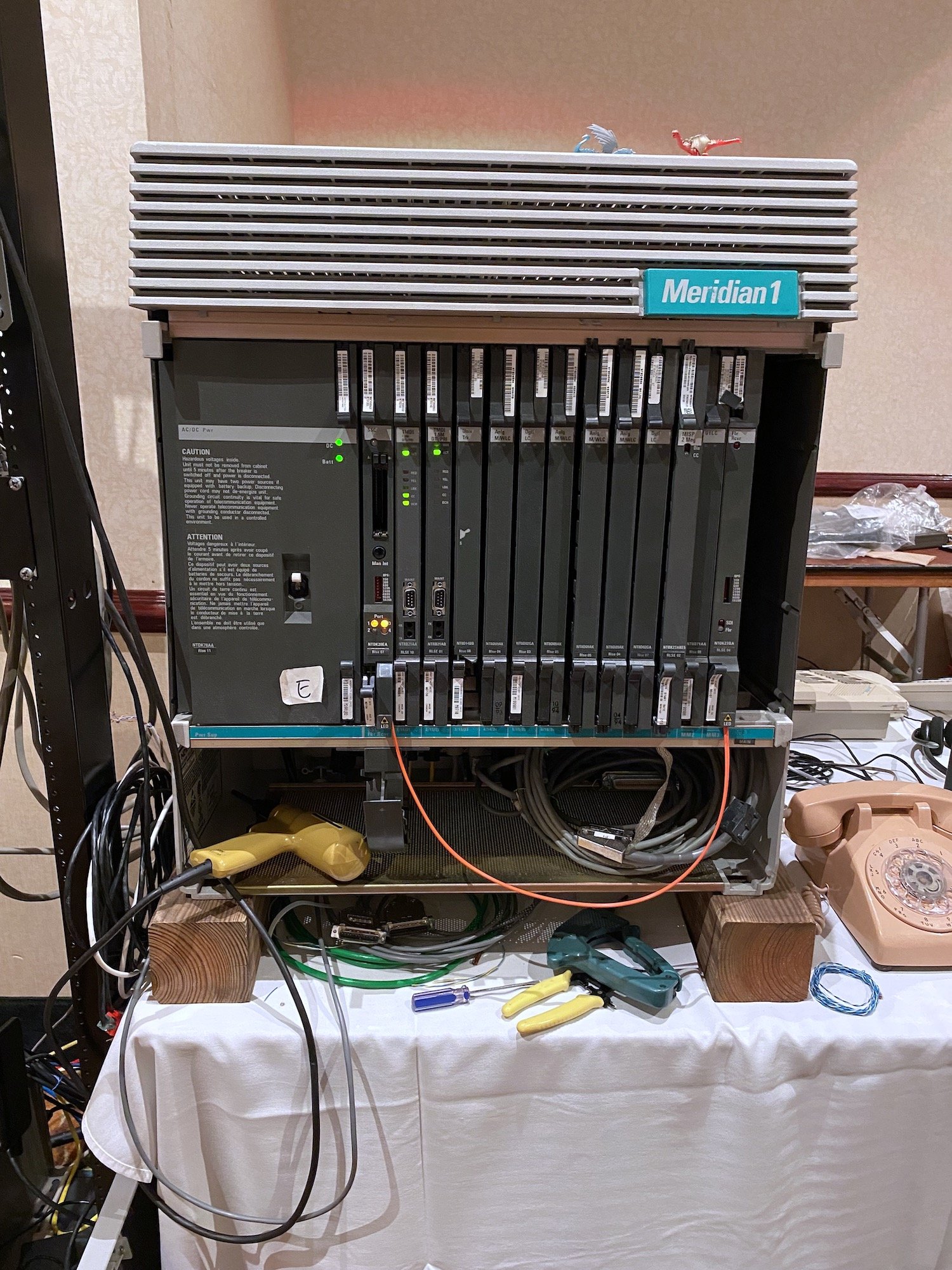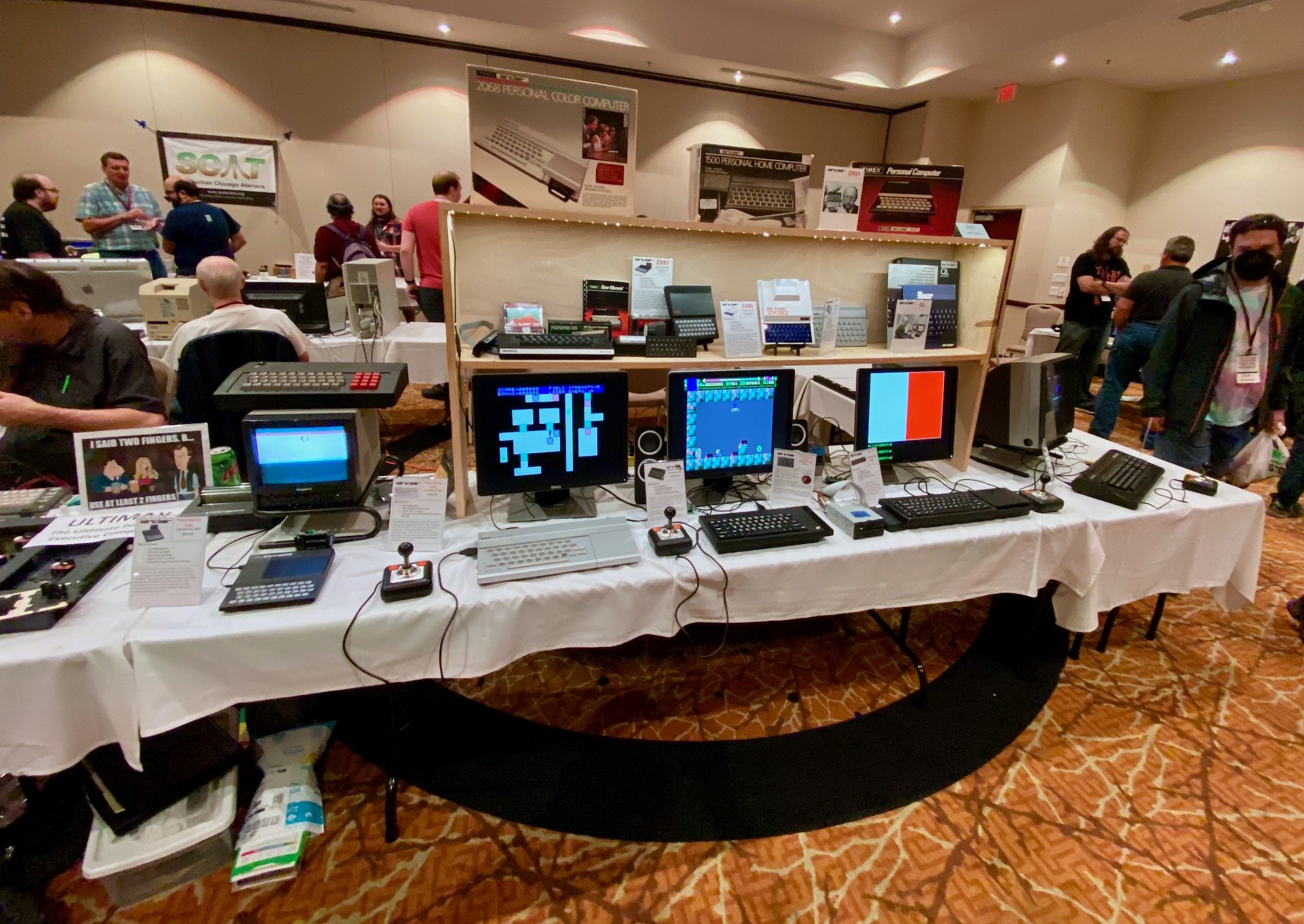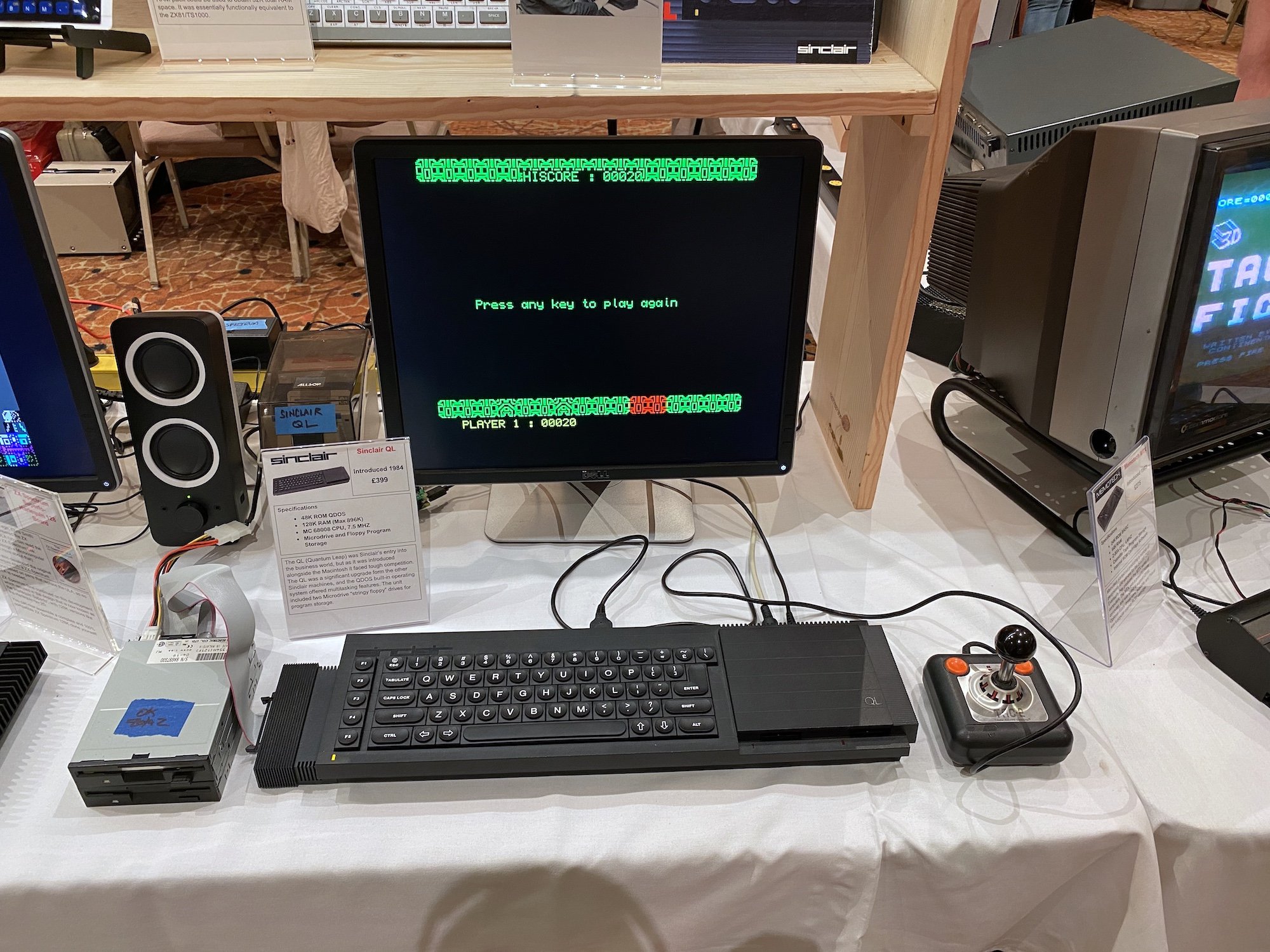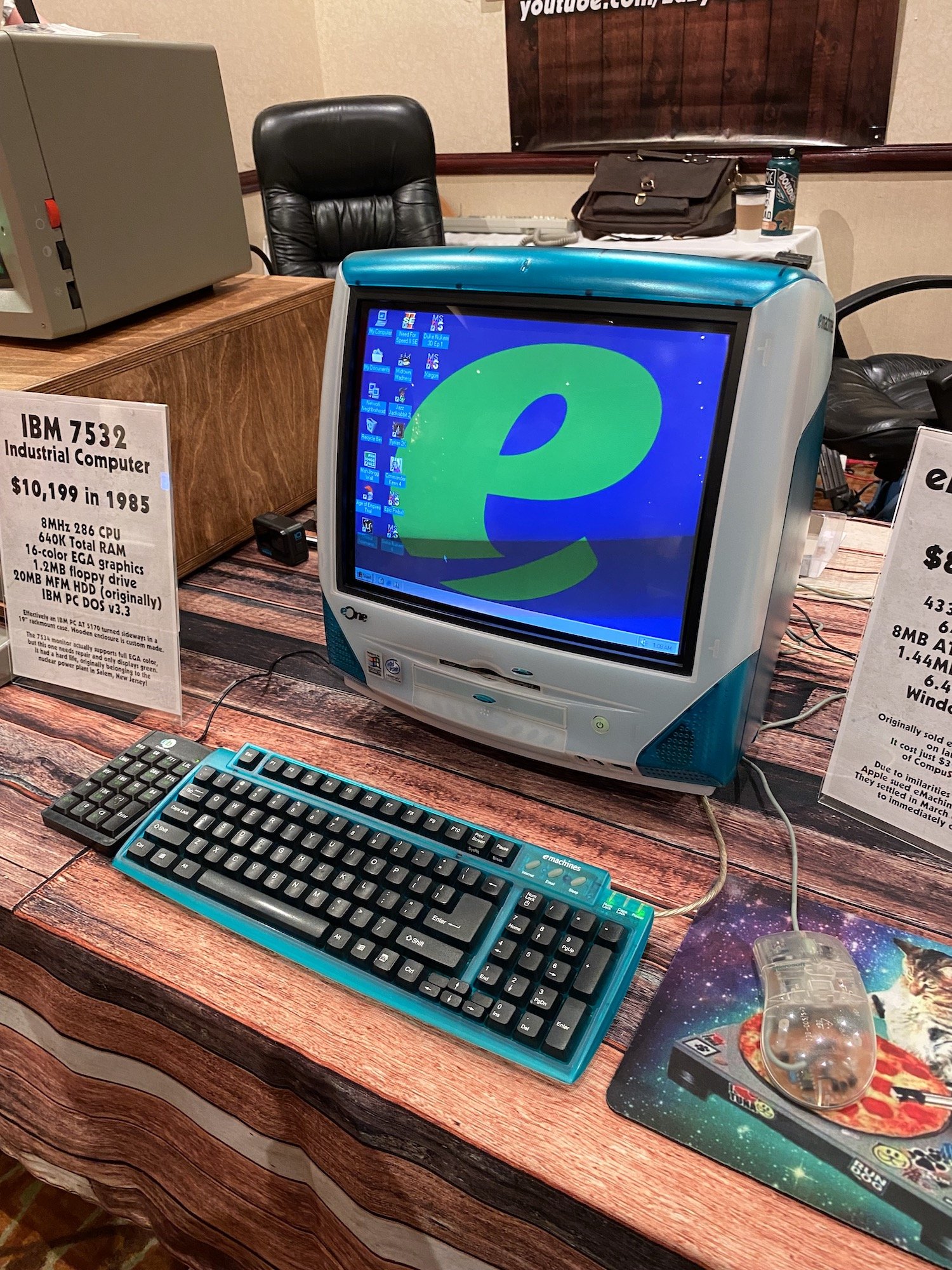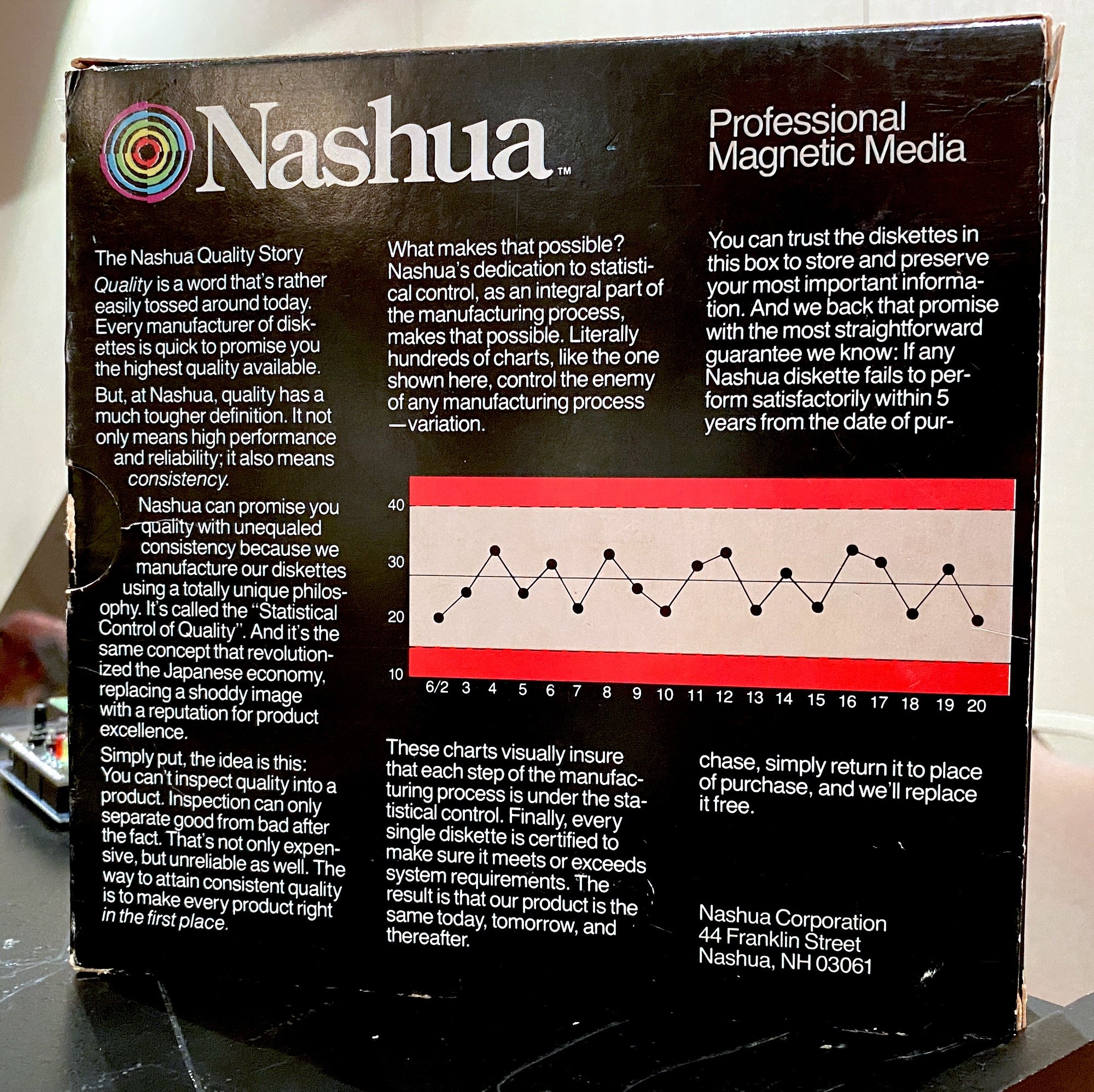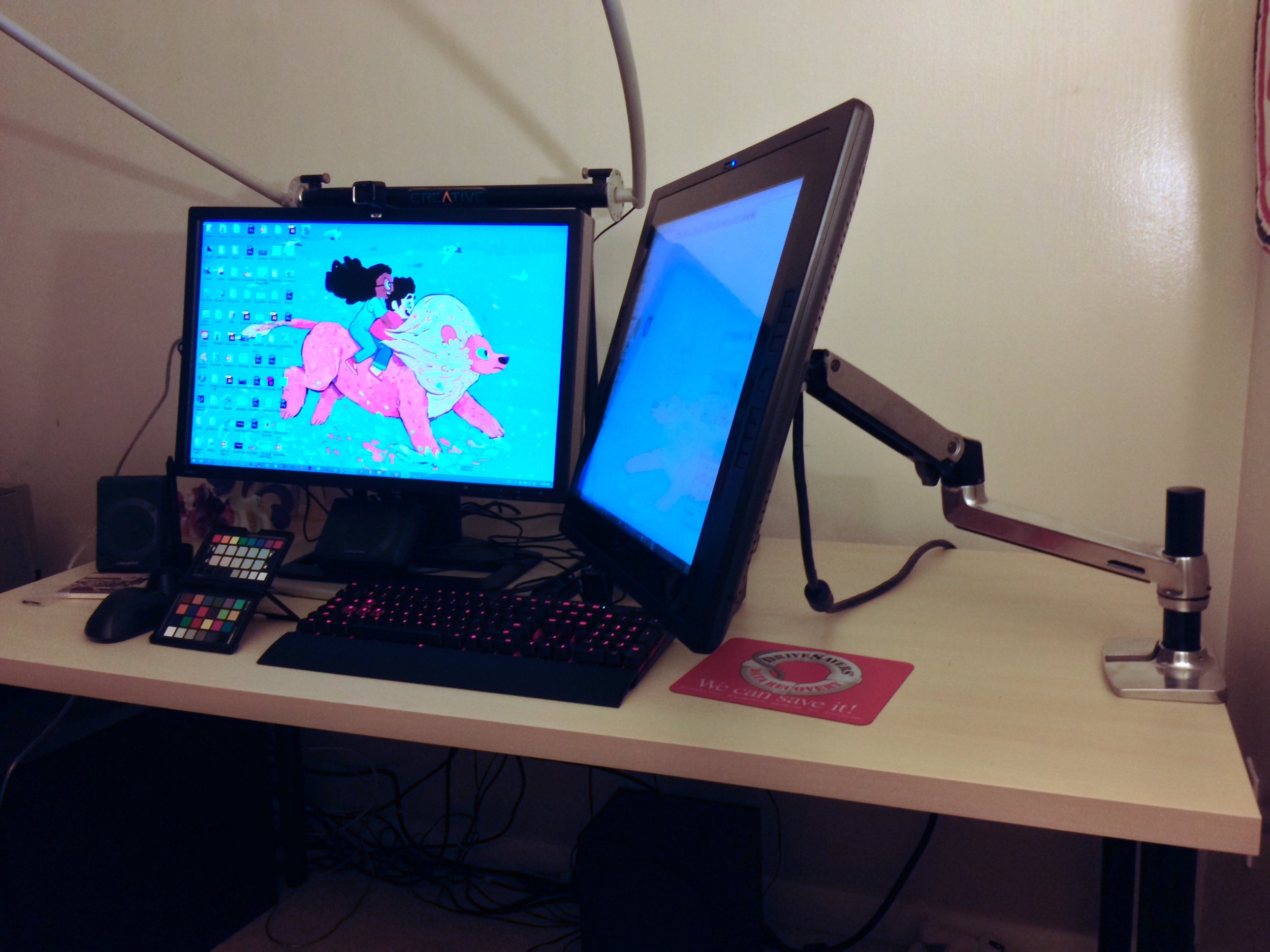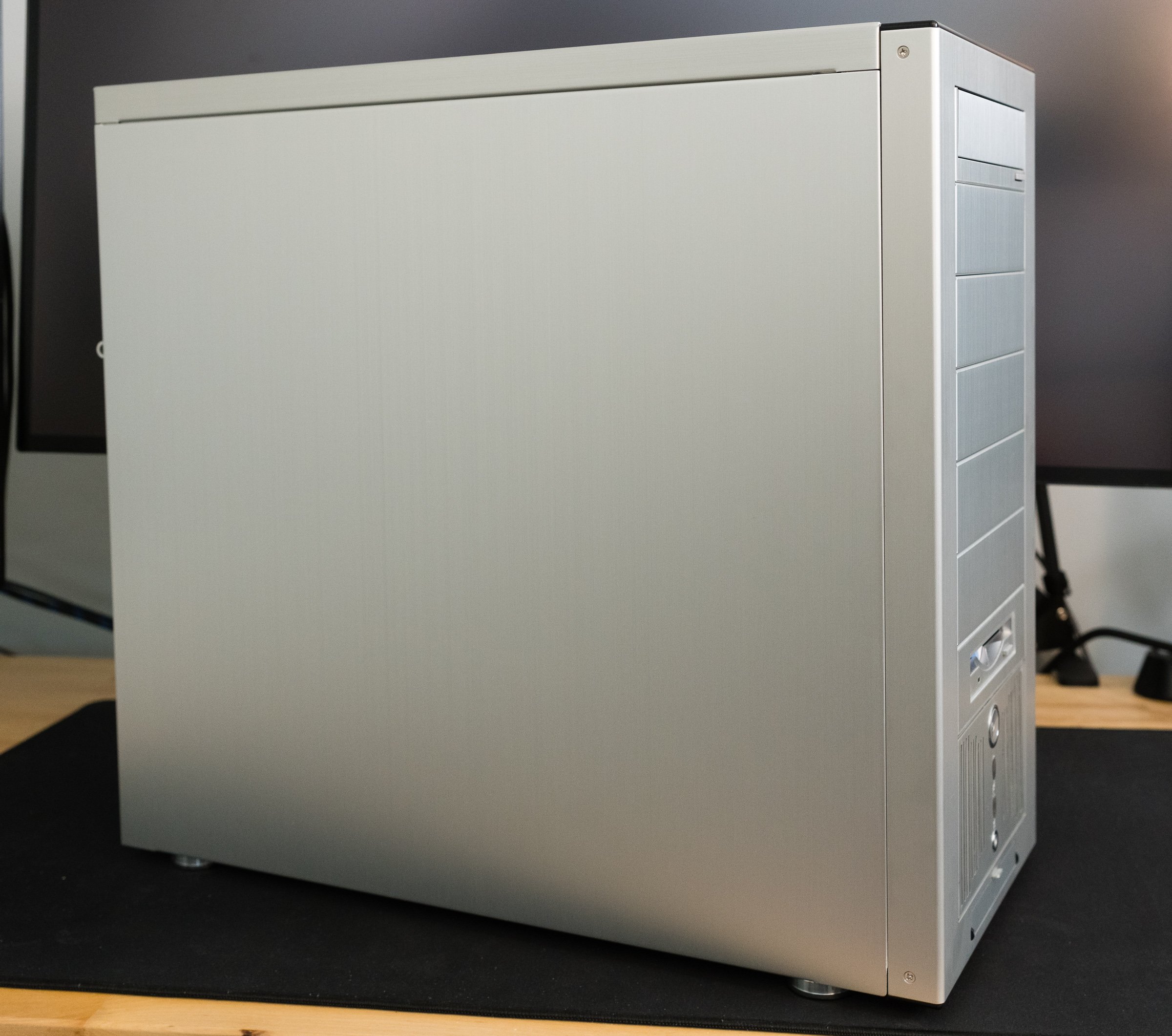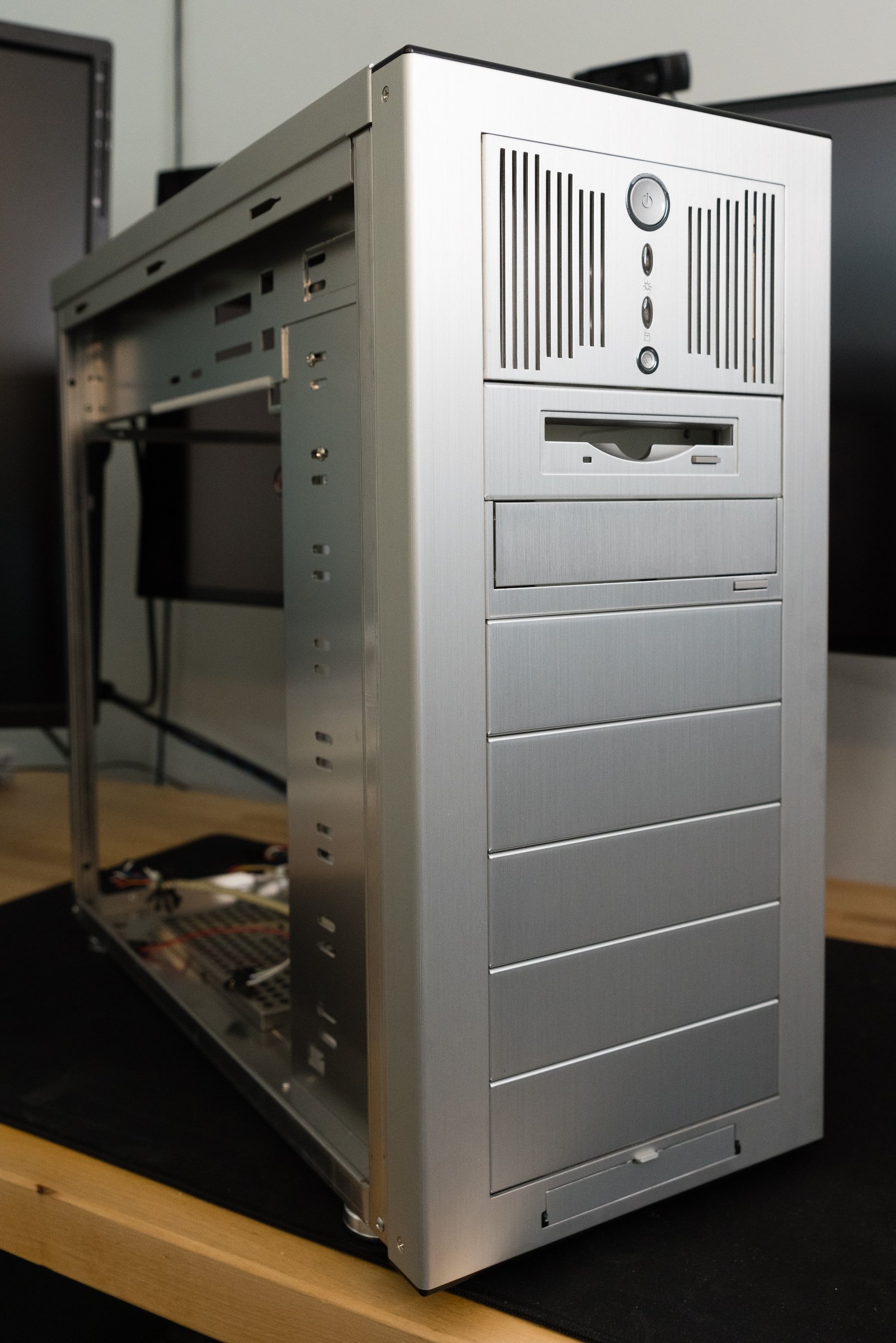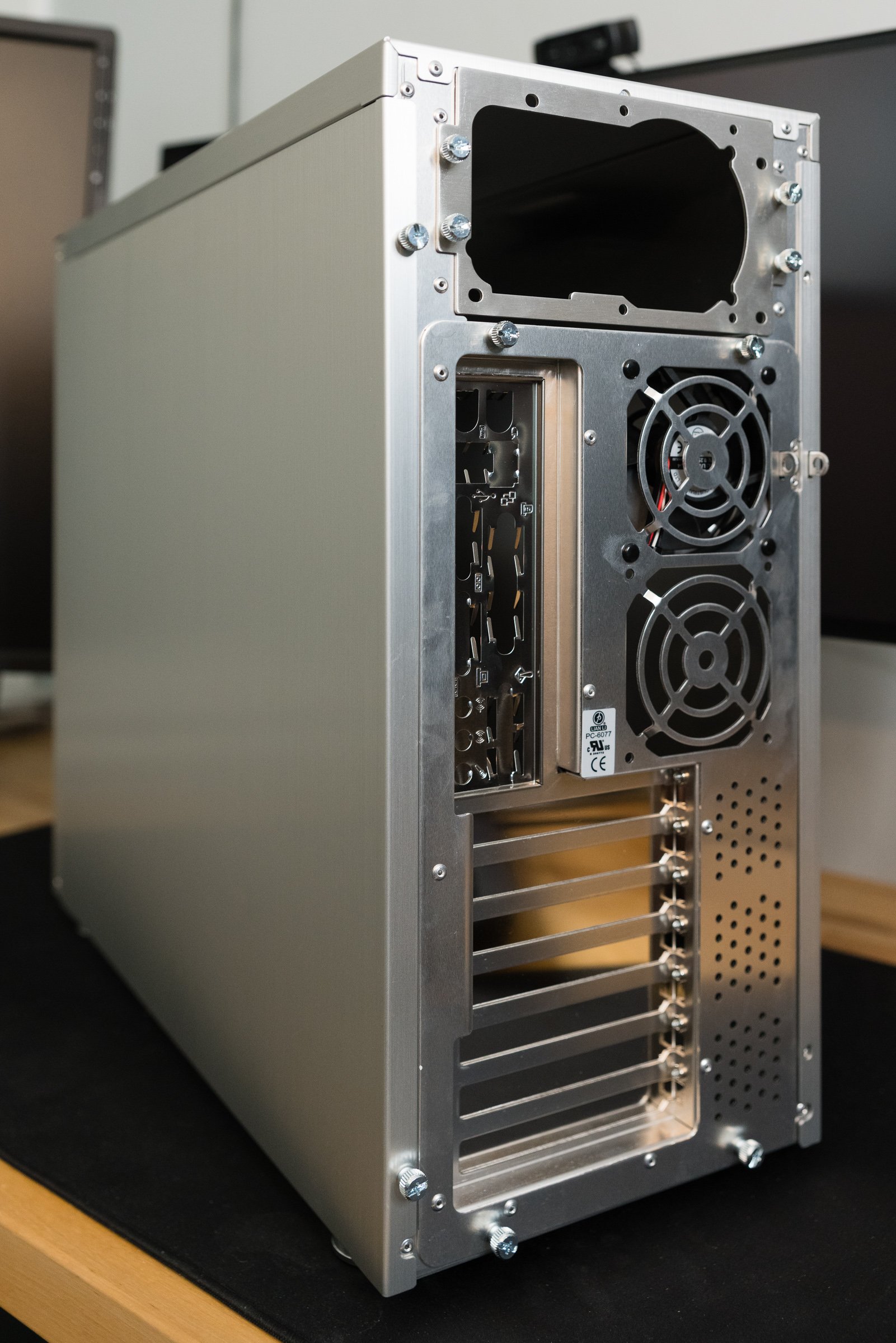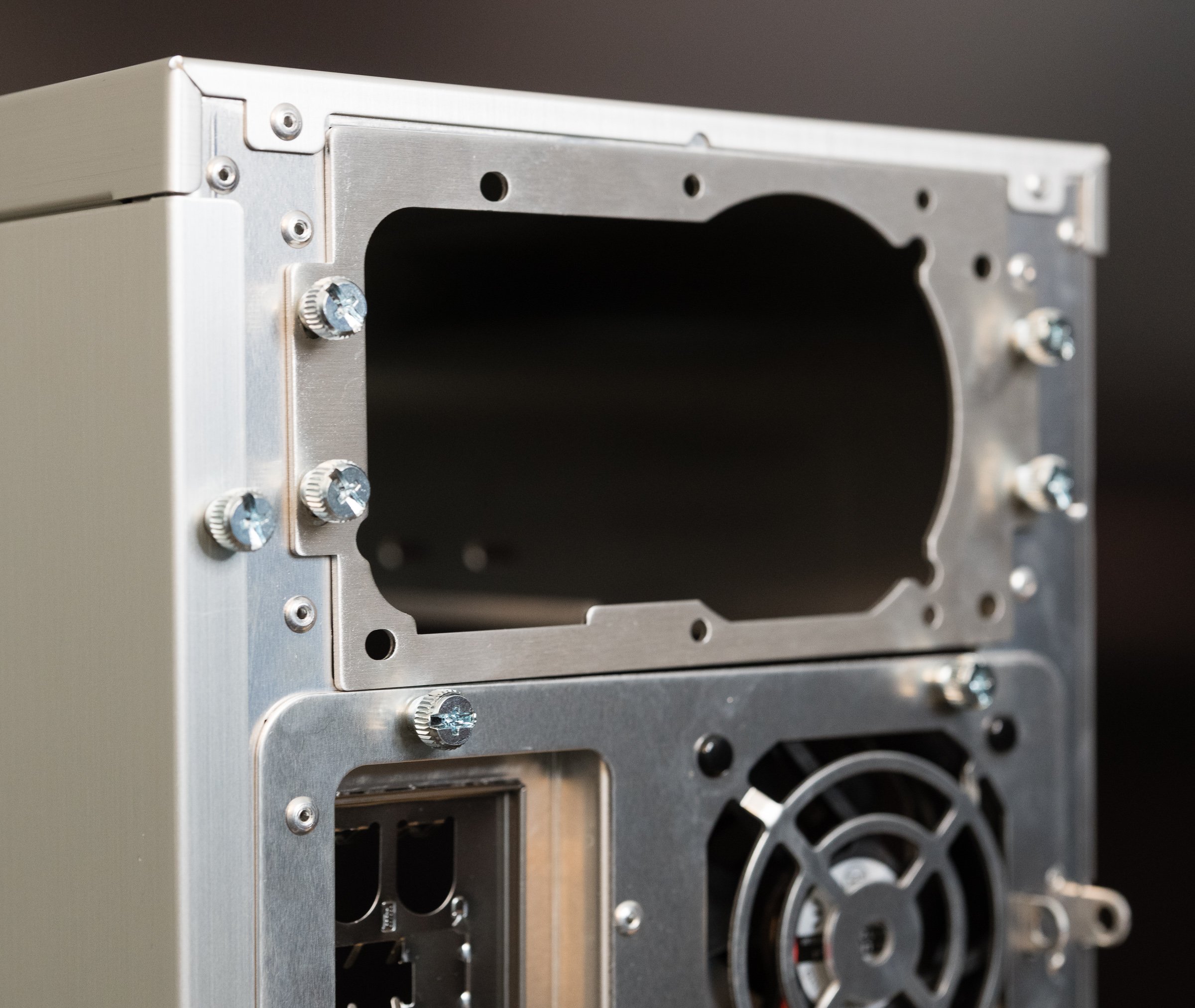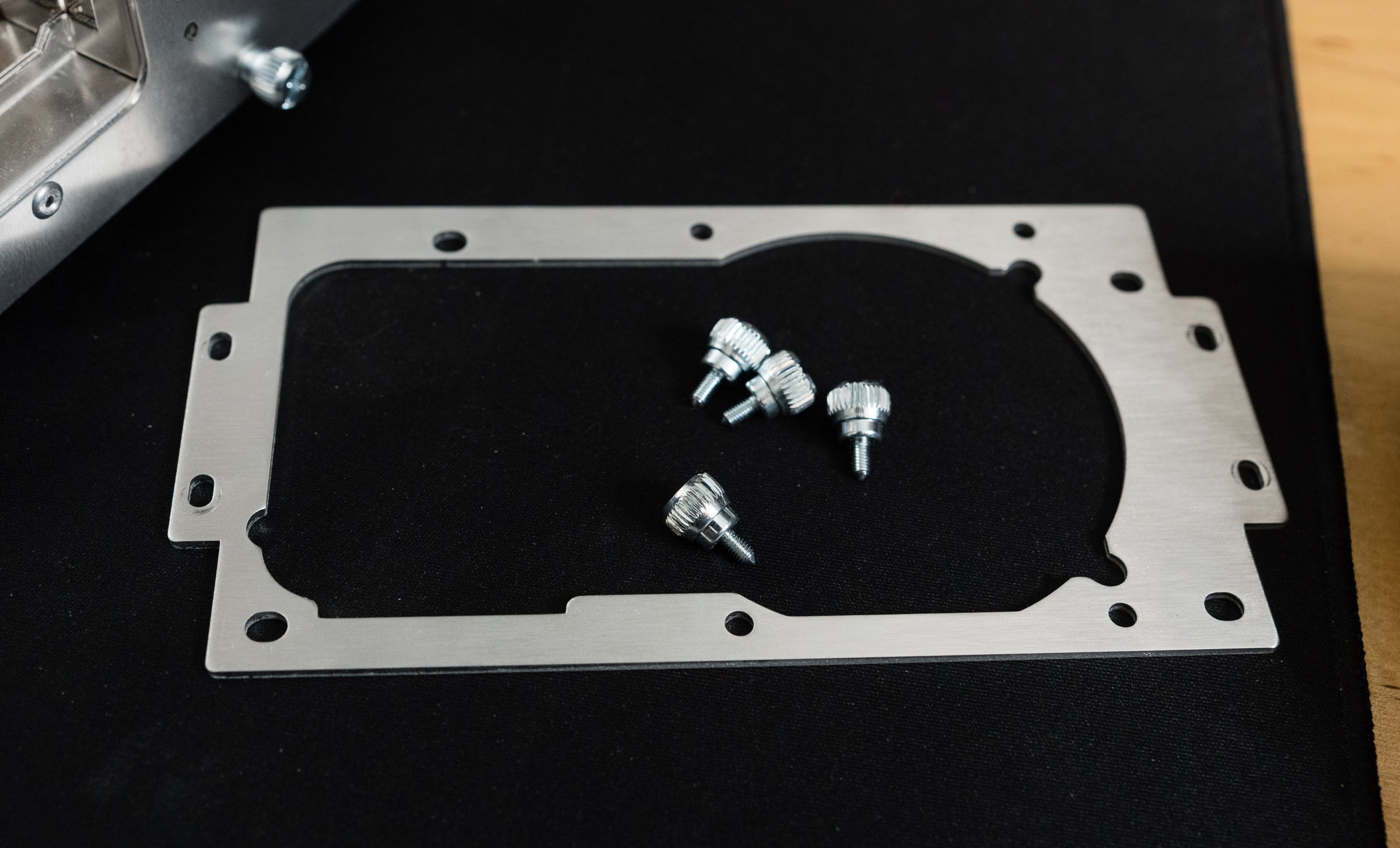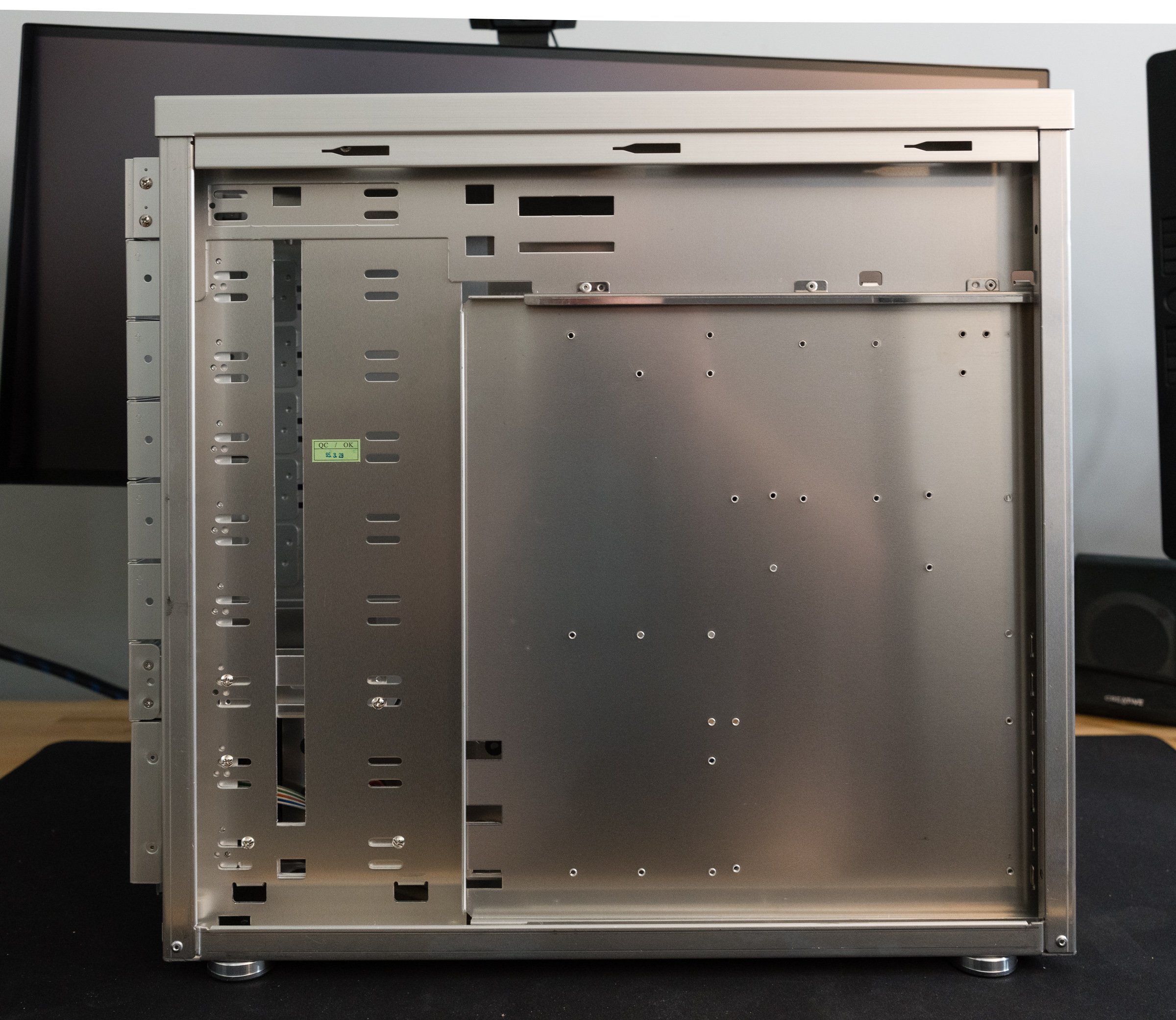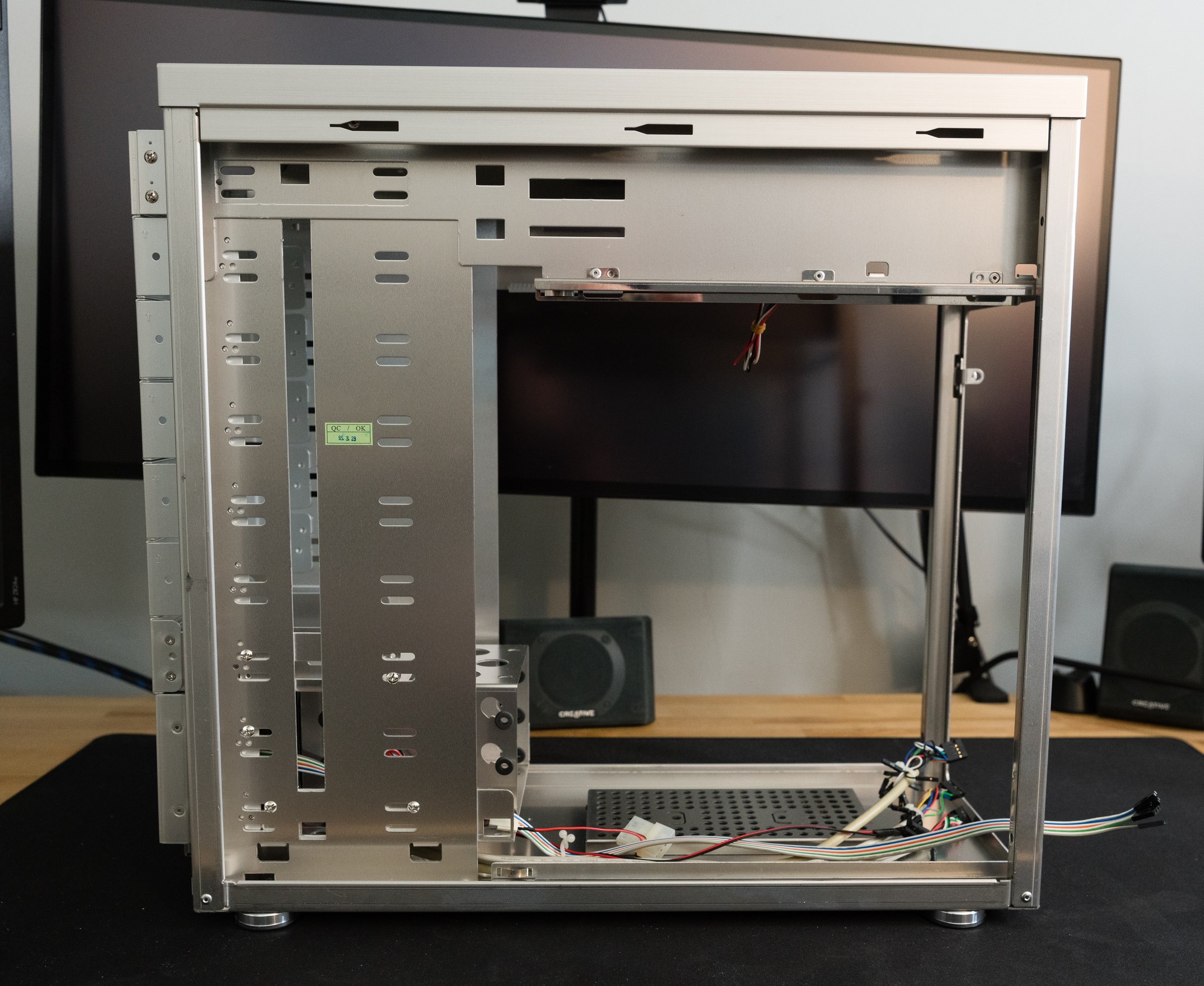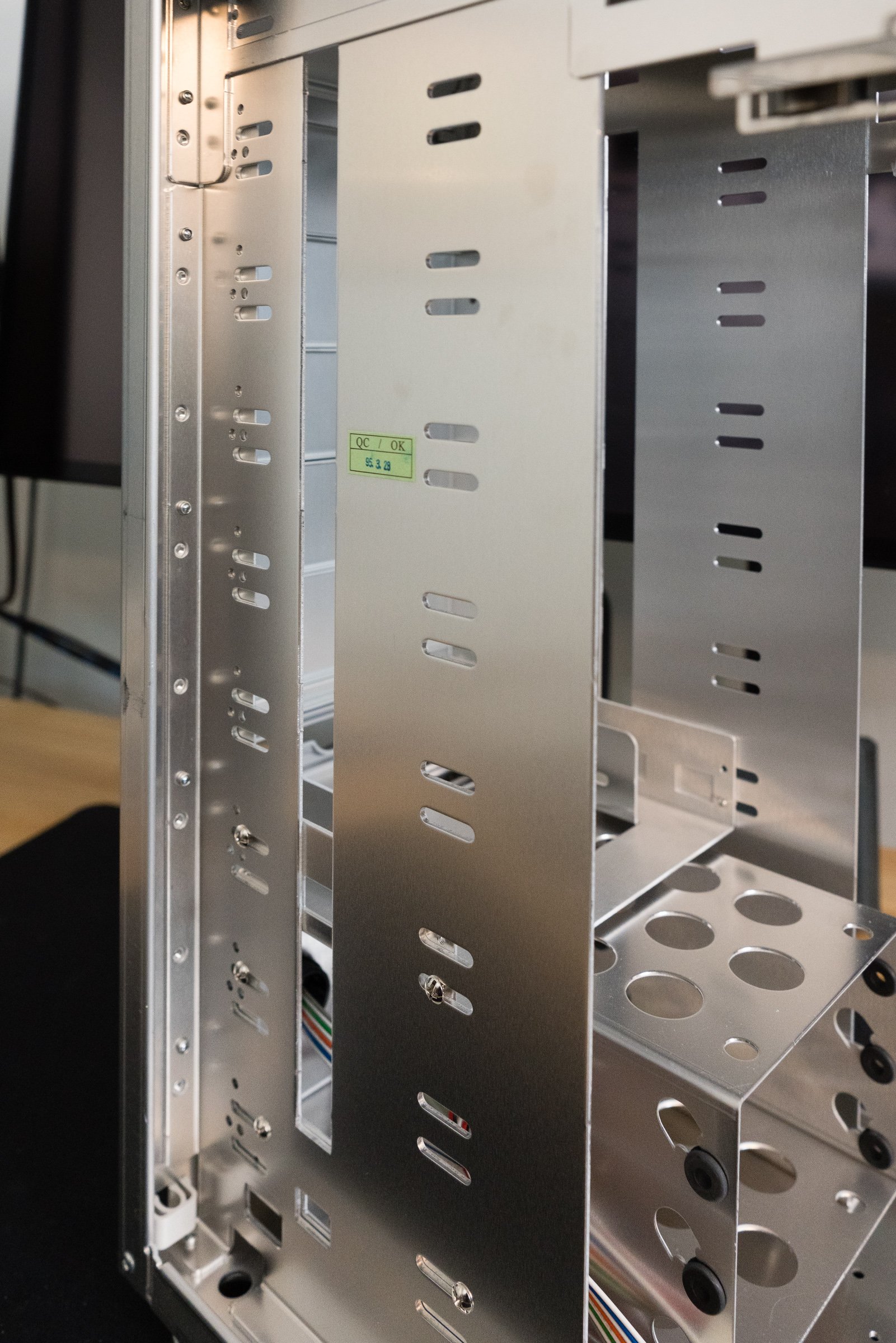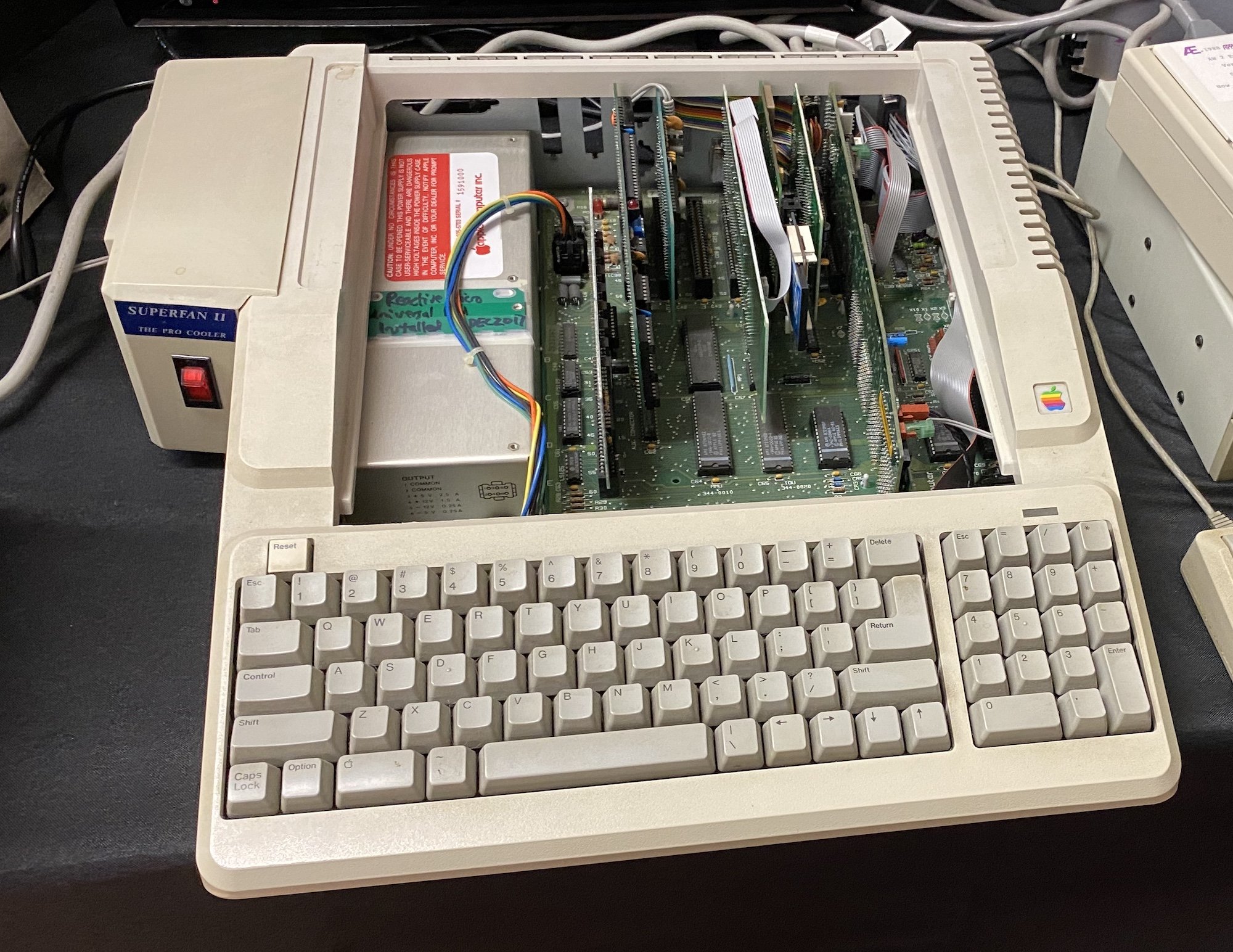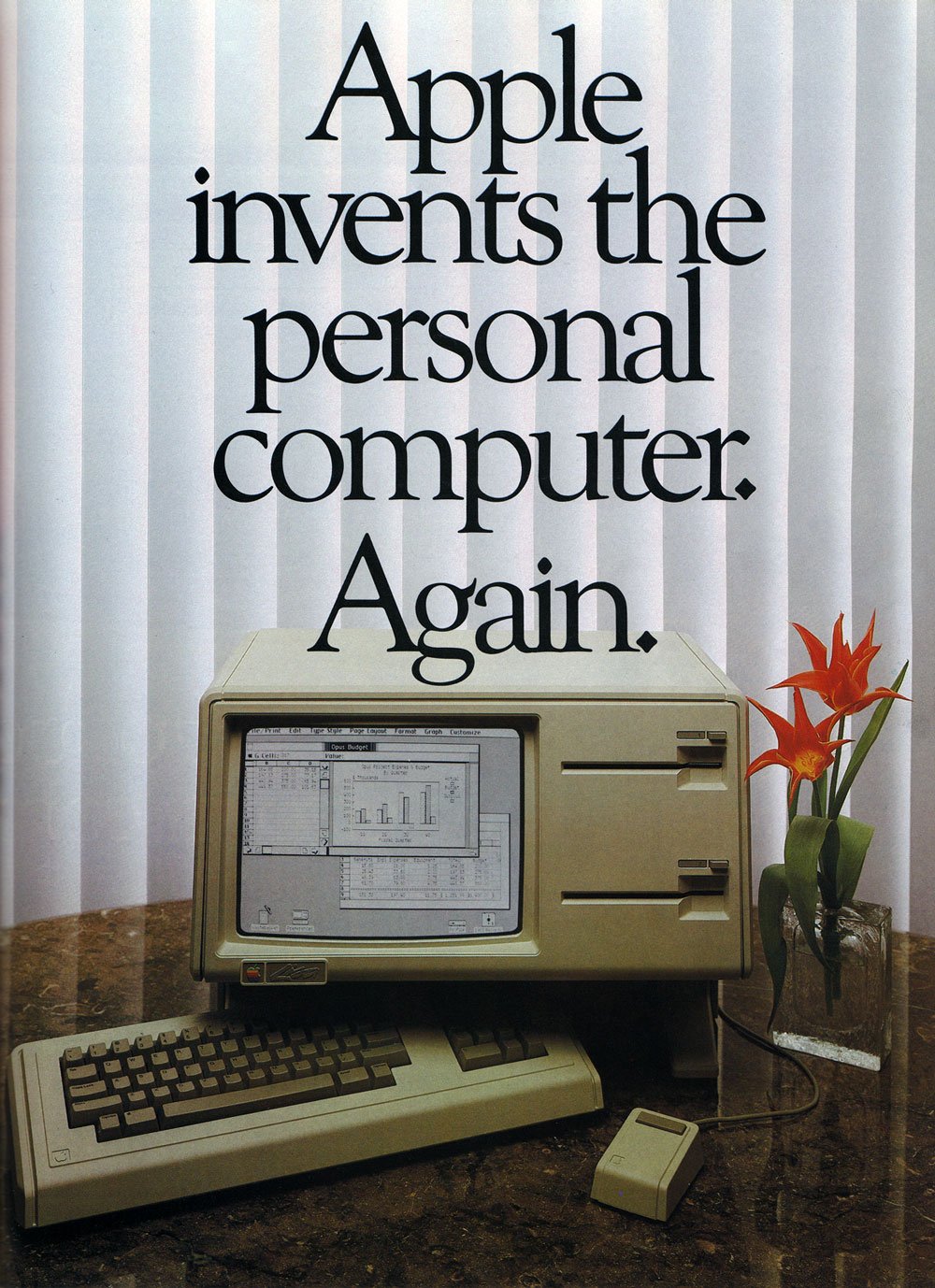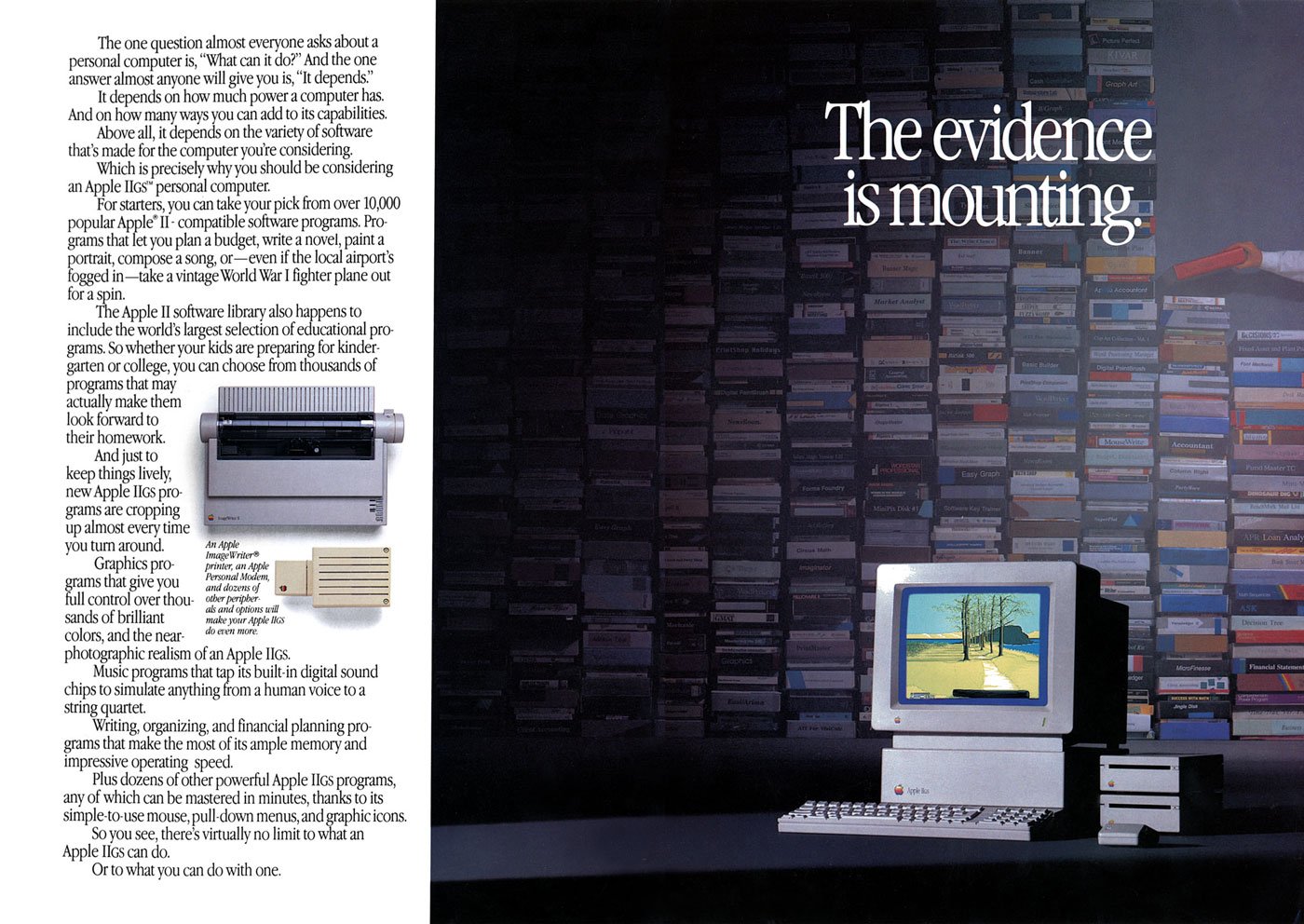A Visit to the Apple Mothership
Here in Userlandia, be very quiet. We’re hunting dogcows.
Brands. Can’t live with ‘em, and in today's hellscape they don't let us live without ‘em. No one in technological society knows a life without Conglom-O relentlessly bombarding them with WE OWN YOU at every opportunity. Our collective wills are assailed every day by these corporate giants, so it’s no surprise that instead of rejecting the marketing, we embrace it. We love that logo stamping on our human faces forever, and happily ask for more, because we love Big Branding. How else can we convince ourselves that a trip to Atlanta is incomplete without a visit to the World of Coca-Cola, or that the Ben & Jerry’s Flavor Graveyard is a must-see Vermont landmark? Maybe it’s the decades of pop-culture contamination talking, but I find something comforting about the self-serving fictions that companies tell you during a factory tour.
Our story begins back in April, when I was on vacation in San Francisco. It was my first time back in the bay area since the pandemic started, and when planning the trip I realized I had some spare time left over. What could I do to fill a morning before flying back to Boston? Why, I could finally visit Apple’s worldwide HQ in Cupertino, California! It wasn’t that far of a drive from where I was staying, and I could easily make it back to the airport in time for my 3 PM flight. Sounds like a perfect way to cap off a trip.
Apple’s called Cupertino their home since 1977, when they opened their first corporate offices on Stevens Creek Boulevard. As Apple’s profits grew, so did their need for real estate. By 1985 they’d occupied so many buildings along De Anza Boulevard that they could’ve asked it to be renamed Apple Boulevard if they thought they could get away with it. Some buildings like Mariani 1 were built from scratch, while others were leased for quick move-ins. Instead of a beautiful orchard, Apple found themselves working in a patchwork campus with little to unify the company, and Steve Jobs thought Apple could do better. In a Wired oral history, John Sculley told the story of SuperSite, Steve Jobs' plan to bring everyone in Apple together under one roof. Steve dreamed of a campus that was more like a theme park than a headquarters, complete with ridiculous gimmicks like a bona-fide electrified six-car monorail.
Unfortunately for Steve, SuperSite was one of his many grandiose ideas that wouldn’t come to pass thanks to his forced departure in 1985. But even after his exit, there was still a desire to unify Apple’s workspace. Sculley devised a new, less ostentatious plan for a central Apple campus and found the perfect site. Right across the street from their then-current HQ at Mariani 1 was De Anza Park, the former site of Four-Phase Systems. Apple bought the land from Motorola, bulldozed the property, and constructed six new buildings arranged in a ring. With a quad-like grassy field inside the ring, it felt more collegiate than corporate. Completed in 1993, Apple christened the new site Infinite Loop and gave everyone who moved in an office of their own.
One Infinite Loop.
Unfortunately for Sculley, the road to bankruptcy is paved with good intentions. Thanks to Apple’s ever-growing head count, they kept many of the buildings that the Loop was supposed to replace. These real estate assets quickly became liabilities, though, when Apple's bright future began to dim. Burdened by failing strategies, incompetent management, and bad product, Apple needed radical intervention just to stay alive. That’s when Gil Amelio made the fateful decision to buy NeXT on Christmas 1996 and use their technology to build the future of the company. And while buying NeXT gave Apple a superlative software stack, it also came with another important asset: NeXT’s executive staff. People like Jon Rubinstein and Avie Tevanian spent the rest of 1997 methodically slashing budgets, cutting anything and everything to stave off bankruptcy. Hundreds of employees were laid off, dozens of projects were cancelled, and the Mac lineup was streamlined.
Apple’s radical downsizing left them with a lot of empty buildings they could barely afford. With leases expiring one by one, employees of all ranks consolidated inside Infinite Loop. Gil Amelio gave up his fancy office at Cupertino City Center and moved back into Infinite Loop just in time for Steve Jobs to launch a boardroom coup and kick him out entirely. Jobs settled into an office on the fourth floor of One Infinite Loop after assuming the role of interim CEO in September 1997. His initial reaction to Infinite Loop was about what you’d expect—he didn’t build it, ergo he didn’t like it. But his opinion changed during Apple’s increasingly successful comeback tour. Although it’s now in the shadow of Apple’s new spaceshippy headquarters that landed to the east, Infinite Loop still has significance both to Apple itself and to people like me who survived the beleaguered era.
While Infinite Loop isn’t a public Apple theme park, there’s still two reasons for Apple enthusiasts to visit, even if one technically doesn’t exist anymore. The first is Apple Store Infinite Loop, which used to be Apple’s company store. Many large faceless corporations have a company store selling tchotchkes of middling utility—apparel, sports gear, office supplies, and such. My personal favorite is Boeing’s at their factory in Everett, Washington. Where else can you buy a 747 t-shirt and an easy chair made out of an engine cowling? Some day I’ll work up the courage to spend three grand on that chair—some day.
The Apple Company Store of the nineties bore little resemblance to a modern Apple retail store. It was very much like other company stores selling branded merch to employees and visitors. You could get an Apple logo on pretty much anything from telephones to teddy bears to tote bags. The Company Store served this role until 2015 when it was closed, gutted, and rebuilt as a modern Apple retail experience. Even though Apple Infinite Loop might not look different from the Apple Store at your local mall, it still owes some of its soul to the old Company Store thanks to specially branded merchandise that isn’t available anywhere else.
The Apple Store at Infinite Loop
If you ever wanted a pen that perfectly matched the color of your MacBook Air, or a coffee mug or steel water bottle with an Apple logo, you're in luck. I picked up one of the canvas sketchbooks—in classic beige, of course. Thirty bucks for a half inch of smooth 60-to-80 pound 8x10 paper is a wildly overpriced alternative to a ten-dollar spiral bound drawing pad, but… eh, Apple tax, what're you gonna do. Meanwhile, the other side of the wall had the real cool stuff: T-shirts! Infinite Loop’s Apple apparel appeals to maniacal Macintosh mavens, with designs evoking eras long past. There’s a couple modern designs, like the "Mind Blown" emoji, but by and large these shirts look like they came straight from the nineties. Apple and the T-shirt are inseparable—there’s even a whole book chronicling the history of Apple-related T-shirts. I don't normally talk about clothing, but hey—it’s from Apple, it's soft, and you wear it. Good enough, let’s go.
A quick note: My own photos of the shirts had some issues, rendering them unusable for this segment, apparently. Please forgive me, 9to5mac, for, uh, borrowing yours.
Logo Infinite Loop. A large Apple logo along with Infinite Loop in white Apple Garamond Italic. This is a classic Apple shirt design and a must have, especially in black.
1 Infinite Loop Cupertino Rainbow. More Apple Garamond Italic, but each line of text is a different color of Apple’s rainbow, along with a smaller Apple logo. If Logo Infinite Loop’s big Apple logo is too much, this is your alternative.
CUPERT1NO. The letters of the word Cupertino are arranged in a grid of white uppercase Apple Garamond. A gray numeral 1 replaces the letter I, which matches the gray “Infinite Loop” text below. Neat design, yes, but as someone who's actually designed shirts in his day, I think it'd look better on a poster.
Mind Blown Emoji. You can do better than an emoji. Skip it.
Hello. The latest version of the Macintosh’s Hello script as seen in the M1 iMac’s introduction. If you like subtle shirts, this is your pick. Mac fans will nod in approval, everyone else will just think you’re friendly.
Cupertino Script. The word “Cupertino” written in the same script as Hello. Same vibes as Hello, but even stealthier.
Pirates. An homage to the famous pirate flag that once flew above Apple HQ. The white variant has an emoji-style Jolly Roger flag, while the black version has a big skull and crossbones print on the chest. The eyepatch is a rainbow Apple logo, and printed on the inside neck is the famous Jobs quote “It’s better to be a pirate than join the navy.” The black version is a must have for any classic Apple fan.
Icons. A grid of Susan Kare’s legendary classic Mac OS icon designs are printed all over this shirt. There’s a spray can, stopwatch, command key, Apple logo, happy Mac, and even a bomb. A perfect match for the Classic Mac OS nerd, though the all over print is a very loud design. Whether or not Susan Kare is actually getting royalties for Icons, Pirates, or Hello, she deserves them.
While picking out these shirts, I was assisted by one of Apple’s retail employees. His name was Philippe, and we had a good time chatting about my visit to IL-1 and the various T-shirt designs. Folks like me who come by for a bit of the unique merch and seeing where it all happens aren’t uncommon, and Phil was a pro about it. He had stories about how he got into tech—his dad worked down the road at Sun Microsystems and he grew up surrounded by computers. We had a great talk about my time in the graphics industry and about this very blog, site, podcast—whatever. Hi, Phil! Thanks for listening! After paying for three T-shirts and a sketchbook, my time at the store was done. Now I was ready for the other reason I came to Infinite Loop.
Searching for Clarus
Clarus roams the garden.
Photo: George Sakkestad, Cupertino Courrier
A small park lives at the corner of Infinite Loop 1 and 6. It’s somewhat larger than the other green spaces around the Infinite Loop buildings, with a concrete walkway and some trees dotting the interior. There’s not much to see there, save for those trees. Probably most people who head to the Apple Infinite Loop store walk right by this little patch of greenery without knowing its significance. But for longtime Apple employees and diehard fans who suffered through the bad old days, this otherwise unassuming park means just a little bit more.
Yes, this field is the former home of the famous—or maybe infamous—Icon Garden. As the legend goes, the government of Cupertino asked Apple to contribute to the beautification of their fair city. When Infinite Loop opened in 1993, Apple honored the city’s request by installing twelve foot tall sculptures of pixelated icons from Mac OS and MacPaint. Whether or not larger-than-life versions of icons like a paint bucket, the stopwatch, and Clarus the Dogcow count as art is open for debate, but it was good enough for the city of Cupertino. Thus, the Icon Garden was born. During its five years of existence the Garden was a place of pilgrimage for Apple acolytes—their way of paying homage to the whimsy that made them fall in love with a computer in the first place. This was when I was a teenager, so I only knew of the Garden through the pages of Mac magazines and Apple fansites. Taking a trip to Silicon Valley was out of the question, so I had to make do with an online QuickTime VR tour.
A morning stroll along the Garden.
Photo: Steve Castillo, Associated Press
But change was in the air with Steve Jobs’ return to Apple, and no dogcow was sacred. Employees arrived at Infinite Loop one morning in May of 1998 to find all the Icons missing from the Garden. Various theories and explanations as to why Clarus and company went AWOL emerged over the years. One Apple spokesperson said they were removed for cleaning, which was just a deflection. Another answer is from former Apple employee David Schlesinger, who said he cornered Steve at a company party and demanded an answer. Schlesinger posted the following in a Quora answer back in 2015:
“[Steve] admitted he’d had it done, he found them too pixellated, and that they were at that point sitting in a warehouse in Santa Clara.”
That’s a cromulent answer, but I think we should look at it from Steve's perspective. When Steve Jobs and Bill Gates were at the 2007 All Things Digital conference, the subject of righting the good ship Apple came up. Steve’s response is one found on many SEO content farm famous quotation pages today.
“And, you know, one of the things I did when I got back to Apple 10 years ago was I gave the museum to Stanford and all the papers and all the old machines and kind of cleared out the cobwebs and said, let’s stop looking backwards here. It’s all about what happens tomorrow. Because you can’t look back and say, well, gosh, you know, I wish I hadn’t have gotten fired, I wish I was there, I wish this, I wish that. It doesn’t matter. And so let’s go invent tomorrow rather than worrying about what happened yesterday.”
While this referred to Steve shipping off Apple’s in-house library and museum to Stanford, which happened in November 1997, it’s the same mentality that deemed the Icon Garden an anchor rather than an inspiration. I can’t fault Steve here, because Apple in that beleaguered era had a lot of problems, and one of them was an unwillingness to make a break with the past. Killing the past was the right thing to do, because Apple’s habit of navel-gazing often turned into abyss-gazing. The company was dying, and it desperately needed to rid itself of bad habits and dead weight. Mistakes like Copland, QuickDraw GX, and OpenDoc were in the past, and if Apple was to succeed, it needed to focus on the future. If that also meant putting away nostalgic memories of happier times, then so be it. With the museum shipped off and the Icon Garden dismantled, Apple set about inventing the future by designing new products to attract more than just the diehards.
And though wild dogcows no longer roam the fields of Cupertino, there have been recent sightings of this endangered species. Yes, Clarus returns in Mac OS Ventura’s page setup dialog box, where she does backflips in sync with your sheet orientation just like in the good old days. New iMacs proudly say hello in Susan Kare script as rainbows shine over Apple once more. Maybe Apple has found the right balance to honor their past without repeating its mistakes. Or maybe it's just a cynical tug at the heartstrings of people like me, diagnosed with a terminal case of retro brain.
The Icon Garden today.
Having paid tribute to an empty field, I hopped in my rental car and took a quick drive around the loop before I left. That’s when I noticed a fun little easter egg. Even though Steve had the icons dragged into the metaphorical trash, some pixelated parts of the past still persist. Each building is identified by a large numeral set in the classic Chicago font used everywhere in the Mac’s interface all those years ago. So although they weren’t technically part of the Garden, these links to Apple's visual past still remain at Infinite Loop. After completing my drive around the Loop, I set a course for across town. I had one more Apple destination to visit before returning to the airport: Apple Park.
The spaceship awaited.
And One Ring-Shaped Building Binds Them
After a short drive down Stevens Creek Boulevard and a left onto North Tantau Drive, I arrived at the Apple Park Visitor Center. With its tall glass walls and a wooden slat roof, you’d be forgiven for thinking “wait a minute, that sounds like an Apple Store.” Congratulations—you’re right! If you’ve been to one of Apple’s flagship stores like Fifth Avenue, then you have an idea of the Visitor Center’s vibe. Unlike Infinite Loop the public isn’t allowed anywhere near the starship, so we have to settle for a shuttlecraft instead.
The majority of the Visitor Center’s floor space is dedicated to the usual tables lined with Macs, iPhones, and iPads. One wall of the store is dedicated to Apple merch, but the selection is different than Infinite Loop’s. Coffee cups and sketchbooks are out, and baby onesies, tote bags, and flash cards are in. The flash cards were amazing, and I regret not having taken a photo of them. They had a set of them permanently mounted to the wall, arranged like a flower so you could see all the individual cards. Unfortunately, they didn't have any sets for sale that day. On the other side of the wall was a selection of T-shirts, three of which—Mind Blown emoji, Hello, and Cupertino script—are carryovers from Infinite Loop. Apple Park’s location specific design is a color or monochrome ring resembling an aerial view of the spaceship with the words “Apple Park” written below.
The T-Shirt Collection at Apple Park.
Forget about that boring Ring design though, because Apple Park is lucky enough to get two absolutely classic Apple shirt designs with Rainbow Streak and Apple Garamond Rainbow. It’s tough to choose between an Apple logo blazing a rainbow across your chest or the classic rainbow Apple lettering—so I bought them both. Odds are you’ll be buying multiple shirts too. It’s hard to say which store has the better shirt selection. Ignoring the three overlapping designs, Apple Park has two absolute killers in Rainbow Streak and Apple Garamond Rainbow. Infinite Loop has two designs that are equally excellent but have more niche appeal: Pirates and Icons. Despite the awesomeness of Rainbow Streak and Apple Garamond Rainbow, I think the nod has to go to Infinite Loop because its location-branded shirts are better than Apple Park’s. Look at it this way—the Ring and emoji shirts are things I expect employees to wear. The One Infinite Loop shirts are far better souvenirs.
Mixed in with the various bits of merch on the wall is a small tribute to iconic Apple designs. Some photos of the Industrial Design Group’s greatest hits are arranged like plaques in a sports Hall of Fame. Superstars like the iPod and iMac G4 are there, of course, but I was pleasantly surprised to see that they've also got journeyman players like the original Pro Mouse and the clear subwoofer from the Harmon-Kardon Sound Sticks. Following these portraits leads you to Caffe Macs Apple Park, where you could take a break for a slice of pizza or a cup of coffee.
We’re waiting on the veteran’s committee to add a plaque for the cinema display.
After perusing the cafe, I climbed some nearby stairs to visit the center’s other big attraction: the observation deck. Some tables and chairs give the hungry Caffe Macs customers a place to sit back, enjoy their coffee or pizza, and take in a scenic overlook. Both the Steve Jobs Theater and the southeast quadrant of the spaceship are visible from this vantage point. It’s not exactly a sweeping vista that rivals the majesty of Yosemite, but it would be a nice place to watch the hustle and bustle around an Apple Event.
The Observation Deck at Apple Park.
As I took in the view of a meticulously manicured monument to Silicon Valley megalomania, an Apple employee came over to talk to me. I don’t quite remember her name—I’m pretty sure it was Stephanie—and she offered to snap a photo of me in front of the spaceship. I accepted and we got to chatting about my quick tour of both Apple campuses. Steph and I wound up having a great conversation about growing up with Commodore 64s. Having what amounts to an Apple Park Ranger on hand is a nice touch.
A Close Encounter of the Apple Kind.
Having seen and done everything I could at the Visitor’s Center, I hopped in the car and headed towards SFO to catch my flight back to Boston. Was it worth all the time and expense to visit the house that the Steves built? I certainly wouldn’t have planned a whole trip around it—flying from Boston to San Francisco just to buy a T-shirt and visit a patch of grass is well outside my budget. But I enjoy visiting San Francisco and the bay area. I’ve hiked amongst the redwoods, I’ve stood at the base of El Capitan, and I’ve listened to the waves in Monterey. Every time I go, I try to do something different, and this time Apple came up on the list.
Touring Infinite Loop also provided a bit of closure for one of my life’s many “what-ifs.” There’s a branching timeline where I could have been an Apple Genius. After I was laid off from a print shop job in January 2007, I spent a few months looking for new employment. In March I saw that Apple was hiring new Geniuses for their new store at the Holyoke Mall. That’s back when the Genius Bar was still something special, so I tossed my résumé into the mix. A few days later one of Apple’s many recruiters reached out for an interview.
It was one of the better interviews I had at the time. Aside from the usual job interview stuff, Apple put prospective Geniuses through a long, forty question test to determine their technical aptitude. I aced the test, even getting five of the six reasons for why a Mac Pro would have no video when four was sufficient. Both the technical and social sides of the interview went well, and then at the end, the recruiter said "One more thing…” No matter how advanced the skills of a potential employee, Apple sent all new technical hires on a two-week all expenses paid trip to Cupertino to instill the values of truth, justice, and the Jobsian way. At that time of my life I’d never been to San Francisco, and a two-week Apple boot camp sounded like a great opportunity. There was only one problem: the Holyoke Apple Store wouldn’t open until July, which was months away. My bank account was getting pretty thin, I had rent to pay, and I wasn’t sure if I could hold out until then.
Until we meet again, SFO.
While talking to Apple I also had an interview with what would eventually be my next employer. It was a job that was available right away and they would cover my relocation expenses so I could move to the Boston area. I said no to Apple, which was the right thing to do at the time. But whenever you make a choice, there’s always that nagging wonder that never goes away. What would my life have been like if I’d taken that two week trip to Cupertino? Maybe I would have been an Apple Store superstar, or maybe I would have turned into yet another jaded Apple employee. In the words of Little Texas, there’s no way to know what might have been. Life’s about making decisions, and you have to live with them—good or bad. Things worked out all right in the end, and now I can put those nagging thoughts out of my mind for good.
If you find yourself in the Cupertino area, stop by Infinite Loop. Technology is the way it is today because of the people that walked its paths, and it’s worth the trip if you’re like me and care about the mythology of personal computing. Or you can buy all the exclusive merch and lord it over your friends. No judgment on that front, because I’m a consumer whore too (and how!). Just make sure to leave a treat for Clarus on your way out.
Oh… one more thing.
With all the time I spent talking about the unique T-shirts offered at these stores, I should at least give an honest review of them as shirts. I admit to being slightly embarrassed over the amount of money I spent on what amounts to wearable corporate advertising—but only slightly. Apple’s obeying the laws of band shirt pricing at $40 apiece, so make sure you’re happy with the fit and style before spending the bills. Or just use the 14 day return policy—that’s what it’s for! I saved one shirt—Infinite Loop Rainbow—to open up at home and document what exactly that $40 gets you.
It won’t surprise you to learn that Apple shirts come packaged just like any other Apple accessory: in a plain white box with a varnished Apple logo. A protective plastic wrap covers the shirt itself, which is easily disposed of in the recycling. No manufacturer’s tag is present, but the shirts are made in China, just like Apple’s computers. The design is silkscreened onto a 100% lightweight cotton shirt, so set your durability expectations accordingly. I’d characterize the fit as athletic or slim, though I’m not sure how differently they cut the larger sizes versus the smaller ones. No size chart was available, and with no demo shirts to try on, you’re flying a little blind if you’re an inbetweener like me. I normally wear medium sized men’s T-shirts, and I’d characterize the fit as “exact.” There’s not much wiggle room, and the sleeves are a bit short. A large would be just so slightly too big, but with this style of fabric you’re better off going a size up if you’re unsure. I was allowed to buy a shirt, try it on, and return it if the fit wasn’t right, so I advise you to do the same if you’re an inbetweener.
Are these shirts worth forty clams? …Eh. The reality is no, they’re not—they’re probably the worst value of anything you can buy at the two stores. And unlike with band shirts, you don’t have the excuse that the extra margin goes to support the group. Even Nintendo doesn’t charge that much at their World Store in Rockefeller Center for a Samus Aran shirt, and they’re one step below Apple on the “we love our margins” chart. This is crass consumerism at its finest. But as bad of a value as they are… they’re infinitely cool. You’re paying for the excellence of the designs, not the shirt they’re printed on. Of course, if you think these are expensive, look how much a vintage Apple Garamond Rrainbow letter shirt goes for on eBay—buying new is actually cheaper. Just pick the one design you really like, make sure it fits, and take good care of it. Whether the money is worth it is between you, your bank account, and how much you love a rainbow Apple.





